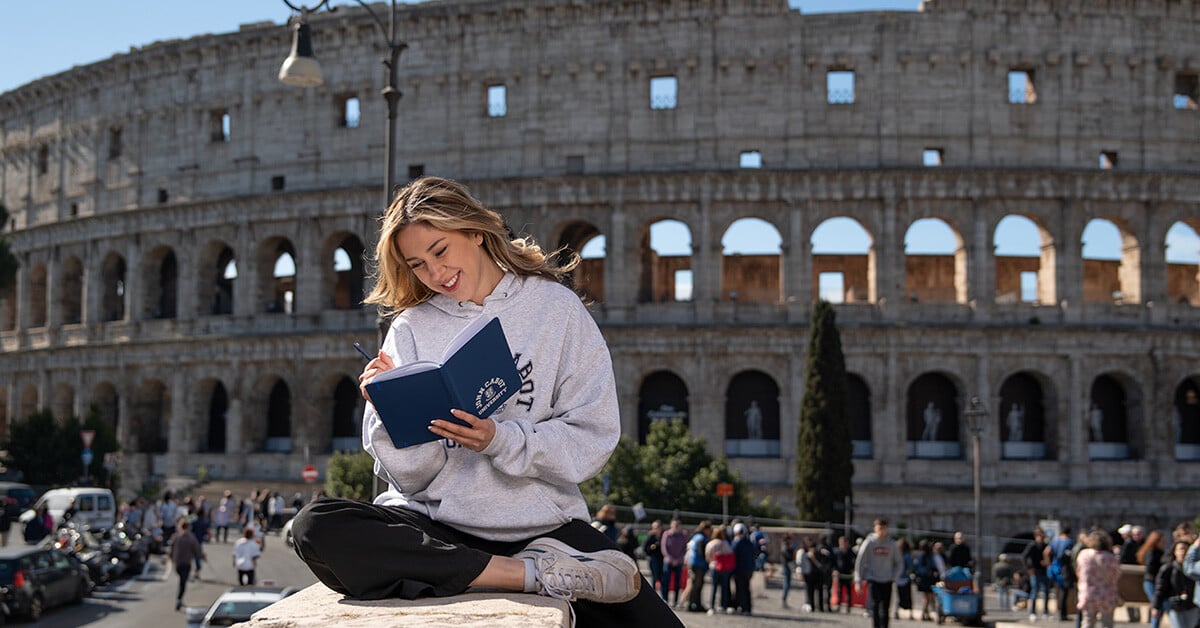

Art history is a captivating field that explores the evolution of art across various cultures and epochs. When you study Art History in Rome, students are introduced to a world where art is seen and experienced in its historical and cultural context.
This field involves understanding the visual languages of the past and present, interpreting meanings embedded in artworks, and appreciating the influence of historical events on artistic expression.
At John Cabot University, studying Art History goes beyond learning facts and dates. It is an immersive exploration of the artworks of the old world and their influence on the present.
The Importance of Analytical Skills in Art History
Analytical skills are crucial when you study Art History in Rome. Students must learn to scrutinize visual materials and discern the nuanced messages they convey.
These skills enable students to ask and answer critical questions about art: What is the purpose behind this artwork? How does it reflect the socio-political context of its time? Why does it resonate differently with various audiences?
Such analysis goes beyond surface-level observation, encouraging a deeper understanding of art as a dynamic entity within human history.
 Prepare to develop excellent analytical skills when you study art history in Rome.
Prepare to develop excellent analytical skills when you study art history in Rome.
Enhancing Interpretation and Critical Thinking
Strong analytical abilities are essential for interpreting artworks, a core component of art historical study. This involves recognizing styles or artists but also requires understanding symbolism, themes, and historical context.
When considering a historical piece, students must explore not just the physical composition of the work but its intention and reception. Why did the artist choose these materials? What does this say about the art movement they were part of? Surrounded by centuries of art evolution In Rome, students' analytical skills are continuously honed, enabling them to make complex interpretations that less trained eyes could miss.
Facilitating Comparative Analysis
Art history at our university in Rome encourages students to engage in comparative analysis, a method involving juxtaposing different artworks to highlight contrasts and similarities. This approach deepens understanding of individual pieces, entire art movements, and historical periods.
Analytical skills are vital here, as students assess why certain styles emerged in specific regions, how cross-cultural exchanges influenced artistic developments, and how similar themes are treated in different artistic contexts.
Rome's historical layers, with their array of ancient ruins, Renaissance art, and modern installations, provide a live canvas on which to practice these skills.
 Studying at our university in Rome will strengthen your analytical skills.
Studying at our university in Rome will strengthen your analytical skills.
Work Your Analytical Muscles When You Study Art History in Rome
The culmination of an art history major at JCU is the senior thesis, a project that demands rigorous analytical skills. Students select a topic and delve deep into research, supported by a faculty member specializing in the subject.
This process reinforces their ability to analyze complex art historical data and prepares them for various career opportunities. Analytical skills are indispensable, whether for a role in academia, curatorial positions in museums, or careers outside the traditional bounds of art history, like journalism or marketing.
Providing A Solid Analytical Foundation
JCU’s Art History program is designed to build and enhance students’ analytical capabilities through a structured curriculum and access to unparalleled resources. From foundation courses that lay the groundwork in art-historical theories to upper-level courses offering specialized knowledge, every aspect of the program strengthens analytical prowess.
Faculty members are recognized scholars in their fields. They are actively involved in research and often include students in these initiatives, providing them with real-world experience in analyzing art historical contexts.
Internships at prestigious institutions like the Museo Nazionale Romano and the Galleria Doria Pamphilj further allow students to apply their analytical skills in professional settings, analyzing artworks, curating exhibitions, and engaging with the public.
These opportunities, combined with the vibrant historical backdrop of Rome, ensure that JCU graduates are proficient in their scholarly pursuits and are prepared to apply their skills in professional environments.
At JCU, students develop the analytical skills necessary to understand art and make insightful contributions to the field and beyond. JCU proudly stands as a beacon for those eager to explore the complex narratives of art and history, equipped with the analytical tools necessary for success in numerous scholarly and professional paths.
Are you ready to attend our American university in Italy?
Contact John Cabot University for more information!




